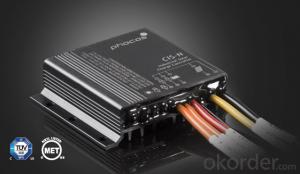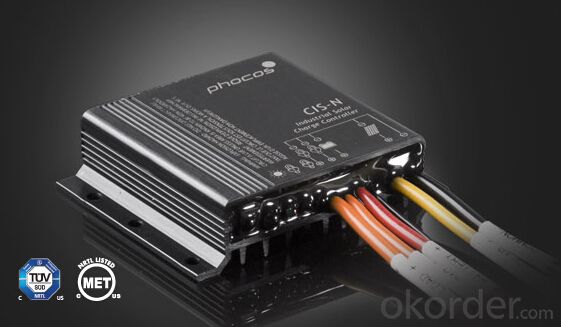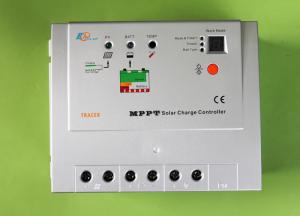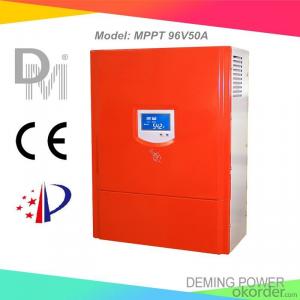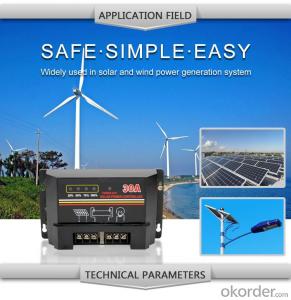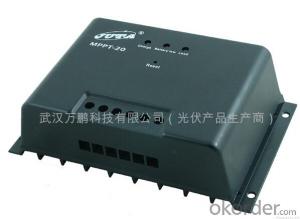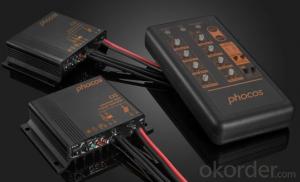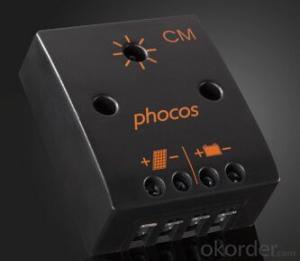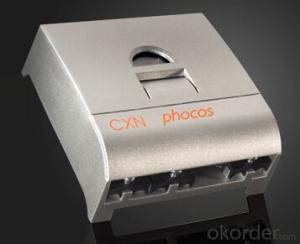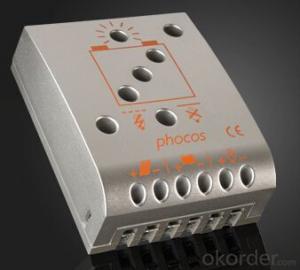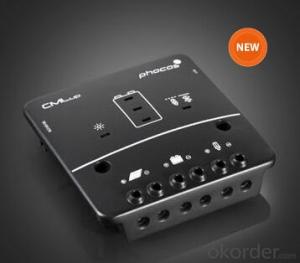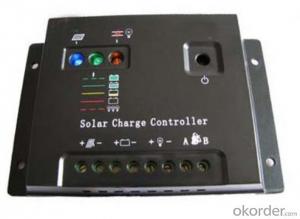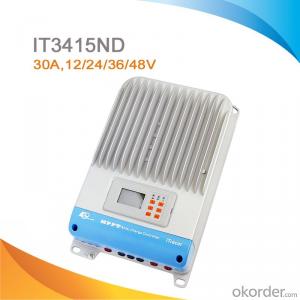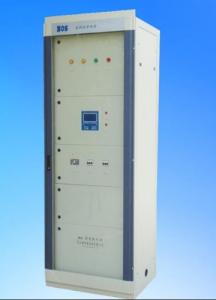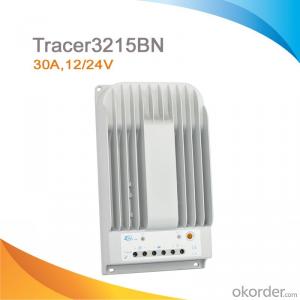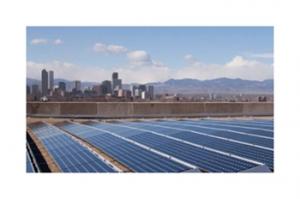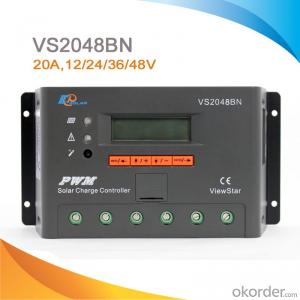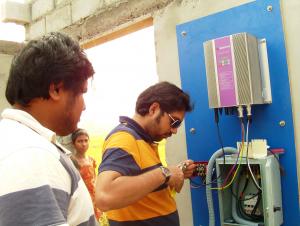Solar Charging Controllers - CIS-N Series (5 – 20 A) Solar Charge Controller
- Loading Port:
- China Main Port
- Payment Terms:
- TT OR LC
- Min Order Qty:
- -
- Supply Capability:
- 10000 unit/month
OKorder Service Pledge
OKorder Financial Service
You Might Also Like
· For applications in demanding and harsh environments (e.g. oil and gas industry)
· Negative grounding
· Robust aluminum housing
· Epoxy encapsulated PCB to prevent corrosion (IP68)
· Infrared remote control programming accessory (CIS-CU)
· Timer functions
· Wide range of programmable functions
· External temperature sensor (optional)
· 4-stage battery charging (main, float, boost, equalization)
· Dual load or dimmable load output
· Automatic system voltage recognition (12/24 V)
· Compact size
The Phocos CIS-N Charge Controller is one of the latest members of the successful Phocos family of fully encapsulated, high-performance CIS charge controllers providing optimum performance. Thanks to its high protection class (IP68), the CIS-N is ideal for applications in demanding environments such as the gas and oil industry (e.g. remote monitoring, weather stations, valves controlling, SCADA, and many more). It is also perfect for any solar outdoor applications which are exposed to harsh weather conditions. CIS-N was specially developed as a charge controller for applications requiring negative grounding, and features the identical properties as the popular positive-grounded CIS.
· It is available in two versions: A single load version with dimming output and a dual load version with two load outputs for independent control of two loads.
· The timer and other useful functions are completely programmable via the CIS-CU remote control unit. The small size of the devices offers extra flexibility, fitting easily into almost every application.
- Q: Can a solar controller be used with a solar-powered hospitality industry?
- Yes, a solar controller can be used with a solar-powered hospitality industry. A solar controller is a crucial component in a solar power system as it manages the flow of energy between the solar panels, batteries, and appliances. In a hospitality industry, where energy consumption is significant, a solar controller can effectively regulate and optimize the energy generated by the solar panels, ensuring a reliable and sustainable power supply for various applications such as lighting, heating, cooling, and other electrical equipment.
- Q: What is the maximum power handling capacity of a solar controller?
- The maximum power handling capacity of a solar controller depends on its specifications and the specific model you are referring to. Solar controllers are designed to regulate the flow of electricity from solar panels to batteries or other devices. The power handling capacity is typically measured in watts and varies based on the size and capabilities of the controller. For example, a small solar controller designed for small-scale or residential applications may have a maximum power handling capacity of around 1000 watts. On the other hand, a larger or more advanced solar controller used in commercial or industrial settings may have a maximum power handling capacity of several thousand watts or even tens of thousands of watts. It's important to consider the power requirements of your solar system and ensure that the solar controller you choose can handle the maximum power output of your solar panels. Oversizing the solar controller can help ensure optimal performance and prevent any potential damage or overheating issues. To determine the maximum power handling capacity of a specific solar controller, it is best to consult the product specifications provided by the manufacturer or seek guidance from a solar professional. They can help you select the appropriate solar controller based on your specific needs and requirements.
- Q: How does a solar controller handle temperature fluctuations?
- A solar controller handles temperature fluctuations by continuously monitoring the temperature of the solar panels or batteries and adjusting the charging parameters accordingly. It uses temperature sensors to detect changes in temperature and modifies the charging voltage or current to ensure optimal charging and prevent damage to the battery or panels. This helps to maximize the efficiency and lifespan of the solar system, even in varying temperature conditions.
- Q: What is the purpose of the low voltage disconnect feature on a solar controller?
- The purpose of the low voltage disconnect feature on a solar controller is to protect the batteries from over-discharge. When a battery is discharged below a certain voltage level, it can cause irreversible damage and significantly reduce its lifespan. The low voltage disconnect feature monitors the battery voltage and disconnects the load, such as appliances or devices, from the battery when the voltage drops below a predetermined threshold. This helps to prevent the battery from being drained too much and ensures that it retains enough charge for proper functioning and longevity. By disconnecting the load, the low voltage disconnect feature helps to safeguard the battery and optimize its performance in a solar power system.
- Q: Can a solar controller be used with solar-powered indoor religious institutions?
- Solar-powered indoor religious institutions can benefit from the use of a solar controller. This crucial component of a solar power system regulates the electricity flow from the solar panels to the batteries, ensuring efficient energy management and preventing overcharging. Although indoor religious institutions may not have direct access to sunlight, they can still harness solar power by installing solar panels on rooftops or nearby outdoor areas. The solar controller plays a vital role in managing the electricity generated by the solar panels and storing it in batteries. This stored energy can then power the indoor facilities, allowing religious institutions to reduce their reliance on conventional electricity sources and contribute to a more sustainable and environmentally-friendly energy alternative.
- Q: Can a solar controller be used with different types of solar charge controllers?
- No, a solar controller generally cannot be used with different types of solar charge controllers. Each type of solar charge controller is designed to work with a specific type of solar panel technology and voltage range. For example, there are different charge controllers for solar panels that use crystalline silicon, thin-film, or amorphous silicon technologies. Additionally, different charge controllers have different maximum voltage and current ratings. Therefore, it is important to choose a solar controller that is specifically compatible with the type of solar charge controller being used to ensure optimal performance and safety.
- Q: What is the maximum charging power of a solar controller?
- The highest rate at which a solar controller can convert solar energy into electrical power to charge a battery or power a load is referred to as its maximum charging power. The specific maximum charging power of a solar controller may vary depending on the model and specifications of the controller. This measurement is typically done in watts (W) or amps (A). Determining the maximum charging power involves considering factors such as the size and quality of the solar panel array, the efficiency of the controller's electronics, and the capacity of the battery being charged. When designing or selecting a system, it is crucial to take into account the maximum charging power of the solar controller to ensure that it can meet the power requirements of the intended application.
- Q: What is the maximum battery voltage that a solar controller can handle?
- The solar controller's capacity to handle battery voltage relies on its specific model and design specifications. Nevertheless, typical solar controllers can accommodate battery voltages ranging from 12V to 48V. To determine the maximum battery voltage that a particular solar controller can handle, it is imperative to refer to the manufacturer's guidelines or technical specifications. Going beyond this maximum voltage threshold has the potential to harm the controller and undermine its performance and functionality.
- Q: How does a solar controller handle battery low voltage protection?
- A solar controller handles battery low voltage protection by continuously monitoring the voltage level of the battery. When the voltage drops below a certain threshold, typically around 11.5 to 11.8 volts, the controller activates a low voltage disconnect (LVD) feature. This feature automatically disconnects the load from the battery to prevent it from further draining and potentially damaging the battery. Once the battery voltage increases to a safe level, the controller will reconnect the load to resume normal operation.
- Q: What is the role of a solar controller in preventing battery undercharging?
- The role of a solar controller in preventing battery undercharging is crucial in ensuring the longevity and optimal performance of solar battery systems. The solar controller acts as an intermediary between the solar panels and the batteries, regulating the flow of energy and preventing the batteries from being undercharged. When solar panels generate electricity, they produce a direct current (DC) that needs to be converted and regulated before being stored in the batteries. A solar controller performs this task by monitoring the voltage and current levels of the solar panels and the batteries. One of the primary functions of a solar controller is to prevent overcharging of the batteries, which can lead to damage or reduce their lifespan. However, it also plays a vital role in preventing battery undercharging. Undercharging occurs when the batteries do not receive enough charge to reach their optimal capacity, resulting in decreased performance and a shortened lifespan. To prevent undercharging, the solar controller constantly monitors the battery voltage and adjusts the charging current accordingly. It ensures that the batteries receive a sufficient amount of charge to replenish any energy that has been consumed, keeping them at a healthy state of charge. The solar controller uses a charge algorithm that takes into account factors such as the battery type, ambient temperature, and charging conditions to determine the appropriate charging current. It adjusts the charging voltage to match the battery manufacturer's specifications, preventing overcharging or undercharging. Additionally, solar controllers often incorporate features like temperature compensation and low voltage disconnect (LVD) to further prevent battery undercharging. Temperature compensation adjusts the charging voltage based on the ambient temperature, ensuring optimal charging regardless of weather conditions. LVD protects the batteries by disconnecting loads when the voltage drops below a certain threshold, preventing excessive discharge and undercharging. In summary, the role of a solar controller in preventing battery undercharging is to regulate the flow of energy from the solar panels to the batteries, monitoring the voltage and current levels to ensure that the batteries receive an adequate charge. By preventing undercharging, the solar controller helps maximize the performance, lifespan, and overall efficiency of solar battery systems.
Send your message to us
Solar Charging Controllers - CIS-N Series (5 – 20 A) Solar Charge Controller
- Loading Port:
- China Main Port
- Payment Terms:
- TT OR LC
- Min Order Qty:
- -
- Supply Capability:
- 10000 unit/month
OKorder Service Pledge
OKorder Financial Service
Similar products
Hot products
Hot Searches
Related keywords
